
Malus is a genus of about 30–55 species of small deciduous trees or shrubs in the family Rosaceae, including the domesticated orchard apple, crab apples and wild apples.

Sasaella is a genus of Japanese bamboo in the grass family.
- Sasaella bitchuensis(Makino) Koidz – southern Honshu
- Sasaella caudiceps(Koidz.) Koidz. – Honshu
- Sasaella hidaensis(Makino) Makino, Hishu zasa – Honshu, Shikoku
- Sasaella hisauchii(Makino) Makino, Hime suzu – Honshu, Shikoku
- Sasaella kogasensis(Nakai) Nakai ex Koidz, Kogashi azuma zasa – Hokkaido, Honshu
- Sasaella leucorhoda(Koidz.) Koidz. – Honshu
- Sasaella masamuneana(Makino) Hatsushima & Muroi, Genkei chiku – Japan
- Sasaella ramosa(Makino) Makino, Azuma zasa – Japan; naturalized in Great Britain + New Zealand
- Sasaella sadoensis(Makino ex Koidz.) Sad.Suzuki – Honshu
- Sasaella sawadae(Makino) Makino ex Koidzum – Honshu
- Sasaella shiobarensis(Nakai) Koidz. – Honshu
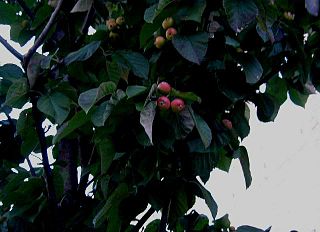
Macromeles tschonoskii is a species of flowering plant in the family Rosaceae. It is a tree endemic to Japan.

Phryma leptostachya, or lopseed, is a perennial herb of the genus Phryma. When distinguished from Phryma oblongifolia and Phryma nana, it is native to eastern North America.

Liparis, commonly known as widelip orchids, sphinx orchids or 羊耳蒜属 is a cosmopolitan genus of more than 350 species of orchids in the family Orchidaceae. Plants in this genus are terrestrial, lithophytic or epiphytic herbs with a wide range of forms. The flowers are usually resupinate and small to medium sized, yellow, yellow-green or purplish with spreading sepals and petals. The labellum is usually larger than the sepals and petals and is lobed, sometimes with a toothed or wavy margin and one or two calli at its base.

Ochrosia is a genus of flowering plants, first described in 1789. It is in the family Apocynaceae, native to Southeast Asia, Australia, and various islands of the Indian and Pacific Oceans.
- Ochrosia ackeringae(Teijsm. & Binn.) Miq. – Indonesia, Philippines, Papuasia, Christmas Island
- Ochrosia acuminataTrimen ex Valeton – Sulawesi
- Ochrosia alyxioidesGuillaumin – Vanuatu
- Ochrosia apoensisElmer – Luzon, Mindanao
- Ochrosia balansae(Guillaumin) Baill. ex Guillaumin – New Caledonia
- Ochrosia basistaminaHendrian – Sulawesi
- Ochrosia bodenheimarumGuillaumin – Vallée de la Toutouta in New Caledonia
- Ochrosia borbonicaJ.F.Gmel. – Mauritius + Réunion; naturalized in Guangdong
- Ochrosia brevitubaBoiteau – New Caledonia
- Ochrosia brownii(Fosberg & Sachet) Lorence & Butaud – Nuku Hiva in Marquesas
- Ochrosia citrodoraK.Schum. & Lauterb. – New Guinea
- Ochrosia coccinea(Teijsm. & Binn.) Miq. – Maluku, Sulawesi, New Guinea, Solomon Islands; naturalized in Guangdong
- Ochrosia comptaK.Schum., Hōlei – Hawaii
- Ochrosia ellipticaLabill. – Lord Howe Island, Queensland, New Caledonia, Vanuatu, Nauru; naturalized in Guangdong + Taiwan
- Ochrosia fatuhivensisFosberg & Sachet – Fatu Hiva in Marquesas but extinct
- Ochrosia ficifolia(S.Moore) Markgr. – New Guinea
- Ochrosia glomerata(Blume) F.Muell. – Borneo, Sulawesi, Philippines, Maluku, New Guinea, Solomon Islands
- Ochrosia grandifloraBoit. – New Caledonia
- Ochrosia haleakalaeH.St.John, Hōlei – Maui + island of Hawaiʻi in Hawaiian Islands
- Ochrosia hexandraKoidz. – Kazan-retto
- Ochrosia inventorumL.Allorge – New Caledonia
- Ochrosia iwasakiana(Koidz.) Koidz. ex Masam.
- Ochrosia kauaiensisH.St.John, Hōlei – Kauaʻi in Hawaiian Islands
- †Ochrosia kilaueaensisH.St.John, Hōlei – island of Hawaiʻi in Hawaiian Islands, but extinct
- Ochrosia kilneriF.Muell. – Queensland
- Ochrosia lifuanaGuillaumin – Loyalty Islands + Isle of Pines in New Caledonia
- Ochrosia mariannensisA.DC. – Mariana Islands
- Ochrosia mianaBaill. ex Guillaumin – New Caledonia
- Ochrosia minima(Markgr.) Fosberg & Boiteau – Queensland, Papua New Guinea
- Ochrosia moorei(F.Muell.) F.Muell. ex Benth. – Queensland, New South Wales
- Ochrosia mulsantiiMontrouz. – New Caledonia
- Ochrosia nakaiana(Koidz.) Koidz. ex H.Hara – Ogasawara-shoto
- Ochrosia newellianaF.M.Bailey – Queensland
- Ochrosia novocaledonicaDäniker – New Caledonia
- Ochrosia oppositifolia(Lam.) K.Schum. – Seychelles, Chagos Islands, Sri Lanka, Maldive Islands, Andaman & Nicobar Islands, Thailand, Vietnam, W Malaysia, Indonesia, Papuasia, Samoa, Tonga, Tuvalu, Vanuatu, Wallis & Futuna, French Polynesia, Line Islands, Micronesia
- Ochrosia poweriF.M.Bailey – Queensland, New South Wales
- Ochrosia sciadophyllaMarkgr – Bismarck Archipelago, Solomon Islands
- Ochrosia sevenetiiBoiteau – New Guinea
- Ochrosia silvaticaDäniker – New Caledonia
- Ochrosia solomonensis(Merr. & L.M.Perry) Fosberg & Boiteau – Solomon Islands
- Ochrosia syncarpaMarkgr. – Bali, Lombok, Timor, Flores
- Ochrosia tahitensisLaness. ex Pichon – Tahiti
- Ochrosia tenimberensisMarkgr. – Tanimbar Islands
- Ochrosia nukuhivensisFosberg & Sachet = Rauvolfia nukuhivensis(Fosberg & Sachet) Lorence & Butaud
- Ochrosia sandwicensisA.DC. = Rauvolfia sandwicensisA.DC.
- Ochrosia tuberculata(Vahl) Pichon = Rauvolfia sandwicensisA.DC.
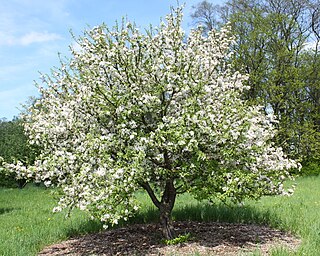
Malus prunifolia is a species of crabapple tree known by the common names plumleaf crab apple, plum-leaved apple, pear-leaf crabapple, Chinese apple and Chinese crabapple. It is native to China, and is grown elsewhere for use as an ornamental tree or as rootstock. It reaches from between 3 and 8 meters tall and bears white flowers and yellow or red fruit.
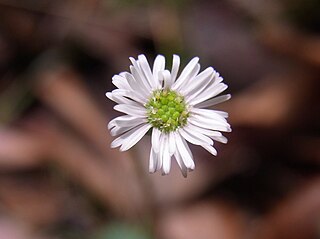
Lagenophora is a genus of flowering plants in the family Asteraceae. Species occur in South-east Asia, Australia, New Zealand, as well as Central and South America.
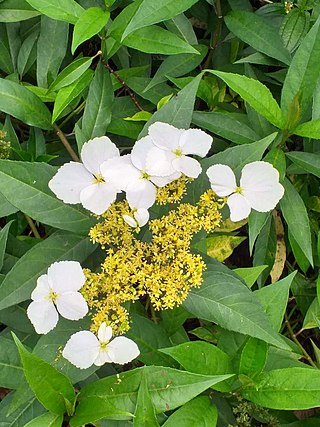
Hydrangea chinensis is a species of flowering plant in the family Hydrangeaceae, native to Myanmar, southeast China, and Taiwan. It grows in valleys and on mountain tops and slopes.

Gen-ichi Koidzumi was a Japanese botanist, author of several papers and monographs on phytogeography including work on roses and Amygdaloideae (Rosaceae), maples (Aceraceae), mulberries, and many other plants. His name is sometimes transliterated as Gen’ichi or Gen-Iti, or as Koizumi.

Malinae is the name for the apple subtribe in the rose family, Rosaceae. This name is required by the International Code of Nomenclature for algae, fungi, and plants, which came into force in 2011 for any group at the subtribe rank that includes the genus Malus but not either of the genera Rosa or Amygdalus. The group includes a number of plants bearing commercially important fruits, such as apples and pears, while others are cultivated as ornamentals.

Heloniopsis, also called swamppink, is a genus of plants in the Melanthiaceae, first described as a genus in 1859. It is native to east Asia.
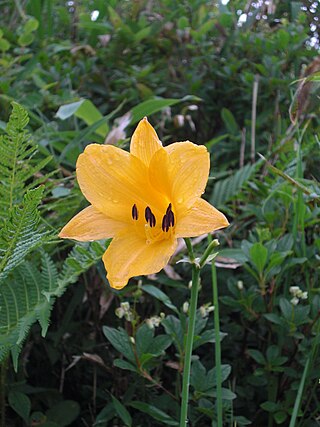
Hemerocallis middendorffii var. esculenta known as nikkōkisuge or zenteika is a perennial plant belonging to the family Asphodelaceae. It is native to Japan. Its yellow flower blooms in early summer, especially in the highlands of Japan in large groups.
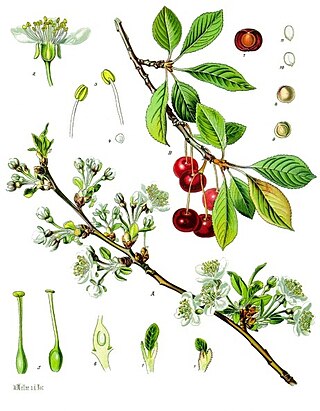
Prunus subg. Cerasus is a subgenus of Prunus. Species of the subgenus have a single winter bud per axil. The flowers are usually in small corymbs or umbels of several together, but some species have short racemes. The fruit is a drupe and has no obvious groove along the side. The subgenus is native to the temperate regions of the Northern Hemisphere, with two species in North America, four in Europe, two in North Africa, and the remainder in Asia.

Phryma is a genus of flowering plant in the family Phrymaceae, native to temperate Asia and eastern North America.
Carex × uzenensis is a hybrid species of sedge and is native to Japan. Its parents are Carex forficula and Carex podogyna.
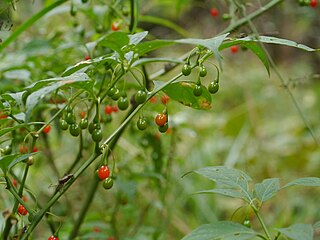
Tubocapsicum is a genus of flowering plants belonging to the family Solanaceae.

Phryma nana is a species of flowering plant in the family Phrymaceae, native to Japan. It was first described by the Japanese botanist Gen-ichi Koidzumi in 1939. Its status as a separate species was not usually accepted, and it was treated as a subspecies or variety of Phryma leptostachya. In 2016, the distinctiveness of the Japanese P. nana was again supported, based on both earlier molecular phylogenetic analysis and morphological analysis. As of April 2022, the species is recognized by Plants of the World Online.

Phryma oblongifolia is a species of flowering plant in the family Phrymaceae, native from temperate Asia southwards to the Himalayas and north Vietnam. It was first described by Gen-ichi Koidzumi in 1929. Its status as a separate species was not usually accepted, and it was treated as a variety of Phryma leptostachya. In 2014, the distinctiveness of North American P. leptostachya and Asian P. oblongifolia was supported, based on morphological evidence and a previous molecular phylogenetic study. As of April 2022, the species is recognized by Plants of the World Online.


















